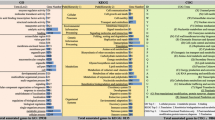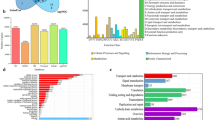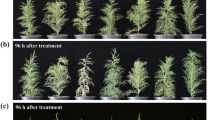Abstract
Dunaliella viridis is one of the most salt-tolerant eukaryotes and a model organism to study plant adaptation to salinity. To explore the molecular mechanisms mediating salt stress response in D. viridis, transcriptome analysis was performed by high-throughput sequencing. A total of 2242 differentially expressed genes (DEGs) were obtained, including 1563 upregulated and 679 downregulated, in plants after 6 h of salt stress (S_6h) compared with the control (Con); 394 DEGs, including 159 upregulated and 235 downregulated, in plants after 1 h of salt stress (S_1h) compared with the control; and 1379 DEGs, including 471 upregulated and 908 downregulated, in S_6h compared with S_1h. GO and KEGG analyses revealed that these DEGs were enriched in biological processes such as metabolism, genetic information transmission, signal transduction, and material transport. Further gene expression analysis and functional annotation showed that genes involved in photosynthesis were induced under salt stress. Ornithine decarboxylase and S-adenosylmethionine decarboxylase involved in polyamine synthesis and metabolism were significantly upregulated. Synthesis of molecules involved in cell cycle regulation such as G1-S phase transition protein, cyclin, and cyclin-dependent kinase was induced under salt stress. Ubiquitin, ubiquitin conjugatase, and 26S proteasome regulatory subunit were significantly different in S_6h vs._S_1h (P < 0.01). We also found that calmodulin (CaM), calcium-calmodulin dependent protein kinase (CaMK), calcium-calmodulin dependent protein kinase kinase (CaMKK), and cGMP-dependent protein kinase genes were significantly upregulated. These results indicate that calcium messenger pathway and cGMP signaling pathway play important roles in salt stress response in D. viridis. Quantitative real-time PCR (qRT-PCR) was used to validate the high-throughput sequencing, and the expression patterns of ten randomly selected genes under salt stress at different time points were further analyzed.







Similar content being viewed by others
References
Assuncao P, Jaen-Molina R, Caujape-Castells J, de la Jara A, Carmona L, Freijanes K, Mendoza H (2012) Molecular taxonomy of Dunaliella (Chlorophyceae), with a special focus on D. salina: ITS2 sequences revisited with an extensive geographical sampling. Aquat Biosyst 8:2
Bohnert HJ, Ayoubi P, Borchert C, Bressan RA, Burnap RL, Cushman JC, Cushman MA, Deyholos M, Fischer R, Galbraith DW (2001) A genomics approach towards salt stress tolerance. Plant Physiol Biochem 39:295–311
Borowitzka LJ, Brown AD (1974) The salt relations of marine and halophilic species of the unicellular green alga Dunaliella the role of glycerol as a compatible solute. Arch Microbiol 96:37–52
Borowitzka MA (2018) The ‘stress’ concept in microalgal biology—homeostasis, acclimation and adaptation. J Appl Phycol 30:2815–2825
Borowitzka MA, Siva CJ (2007) The taxonomy of the genus Dunaliella (Chlorophyta, Dunaliellales) with emphasis on the marine and halophilic species. J Appl Phycol 19:567–590
Buti M, Pasquariello M, Ronga D, Milc JA, Pecchioni N, Ho VT, Pucciariello C, Perata P, Francia E (2018) Transcriptome profiling of short-term response to chilling stress in tolerant and sensitive Oryza sativa ssp. japonica seedlings. Funct Integr Genomics 18:627–644
Chai YR, Sun Y, Pan WD, Jia YL, Xue LX (2007) Isolation and characterization of rbcL gene from Dunaliella salina. Life Sci J 4:6–12
Charneco GO, Parages ML, Camarena-Gómez MT, Jiménez C (2018) Phosphorylation of MAP kinases crucially controls the response to environmental stress in Dunaliella viridis. Env Exp Bot 156:203–213
Du L, Poovaiah BW (2005) Ca2+/calmodulin is critical for brassinosteroid biosynthesis and plant growth. Nature 437:741–745
Fang L, Qi S, Xu Z, Wang W, He J, Chen X, Liu J (2017) De novo transcriptomic profiling of Dunaliella salina reveals concordant flows of glycerol metabolic pathways upon reciprocal salinity changes. Algal Res 23:135–149
Fernandes J, Morrow DJ, Casati P, Walbot V (2010) Distinctive transcriptome responses to adverse environmental conditions in Zea mays L. Plant Biotech J 6:782–798
Gao X, Cong Y, Yue J, Xing Z, Wang Y, Chai X (2019) Small RNA, transcriptome, and degradome sequencing to identify salinity stress responsive miRNAs and target genes in Dunaliella salina. J Appl Phycol 31:1175–1183
Gong L, Zhang H, Gan X, Zhang L, Chen Y, Nie F, Shi L, Li M, Guo Z, Zhang G (2015) Transcriptome profiling of the potato (Solanum tuberosum L.) plant under drought stress and water-stimulus conditions. PLoS One 10:e0128041
Goyal A (2007) Osmoregulation in Dunaliella, part I: effects of osmotic stress on photosynthesis, dark respiration and glycerol metabolism in Dunaliella tertiolecta and its salt-sensitive mutant (HL 25/8). Plant Physiol Biochem 45:696–704
Groppa MD, Benavides MP (2008) Polyamines and abiotic stress: recent advances. Amino Acids 34:35–45
Hong L, Liu J-L, Midoun SZ, Miller PC (2017) Transcriptome sequencing and annotation of the halophytic microalga Dunaliella salina. Journal of Zhejiang University - Science B 18:833–844
Hummel I (2002) Involvement of polyamines in root development at low temperature in the subantarctic cruciferous species Pringlea antiscorbutica. J Exp Bot 53:1463–1473
Inzé D, De Veylder L (2006) Cell cycle regulation in plant development. Annu Rev Genet 40:77–105
Jia Y, Xue L, Liu H, Li J (2009) Characterization of the glyceraldehyde-3-phosphate dehydrogenase (gapdh) gene from the halotolerant alga Dunaliella salina and inhibition of its expression by RNAi. Curr Microbiol 58:426–431
Jimenez C, Berl T, Rivard CJ, Edelstein CL, Capasso JM (2004) Phosphorylation of MAP kinase-like proteins mediate the response of the halotolerant alga Dunaliella viridis to hypertonic shock. Biochim Biophys Acta - Mol Cell Res 1644:61–69
Kasinathan V, Wingler A (2010) Effect of reduced arginine decarboxylase activity on salt tolerance and on polyamine formation during salt stress in Arabidopsis thaliana. Physiol Plant 121:101–107
Katz A (2001) Plasma membrane electron transport coupled to Na+ extrusion in the halotolerant alga Dunaliella. Biochim Biophys Acta Bioenerg 1504:423–431
Katz A, Pick U, Avron M (1992) Modulation of Na+/H+ antiporter activity by extreme pH and salt in the halotolerant alga Dunaliella salina. Plant Physiol 100:1224–1229
Katz A, Waridel P, Shevchenko A, Pick U (2007) Salt-induced changes in the plasma membrane proteome of the halotolerant alga Dunaliella salina as revealed by blue native gel electrophoresis and nano-LC-MS/MS analysis. Mole Cell Proteomics 6:1459–1472
Krishnamurthy R, Bhagwat KA (1989) Polyamines as modulators of salt tolerance in rice cultivars. Plant Physiol 91:500–504
Liska AJ, Shevchenko A, Pick U, Katz A (2004) Enhanced photosynthesis and redox energy production contribute to salinity tolerance in Dunaliella as revealed by homology-based proteomics. Plant Physiol 136:2806–2817
Livak KJ, Schmittgen TD (2001) Analysis of relative gene expression data using real-time quantitative PCR and the 2−ΔΔCT method. Methods 25:402–408
Maleck K, Levine A, Eulgem T, Morgan A, Schmid J, Lawton KA, Dangl JL, Dietrich RA (2000) The transcriptome of Arabidopsis thaliana during systemic acquired resistance. Nat Genet 26:403–410
Martin-Tanguy J (2001) Metabolism and function of polyamines in plants: recent development (new approaches). Plant Growth Regul 34:135–148
Means AR (1994) Calcium, calmodulin and cell cycle regulation. FEBS Lett 347:1–4
Messiaen J, Cutsem PV (1999) Polyamines and pectins. II. Modulation of pectic-signal transduction. Planta 208:247–256
Mukhopadhyay D, Riezman H (2007) Proteasome-independent functions of ubiquitin in endocytosis and signaling. Science 315:201–205
Olwin BB, Storm DR (1985) Calcium binding to complexes of calmodulin and calmodulin binding proteins. Biochemistry 24:8081–8086
Paciorek T, Friml J (2006) Auxin signaling. J Cell Sci 119:1199–1202
Pick U (1998) Dunaliella—a model extremophilic alga. Isr J Plant Sci 46:131–139
Popova LG, Shumkova GA, Andreev IM, Balnokin YV (2005) Functional identification of electrogenic Na+-translocating ATPase in the plasma membrane of the halotolerant microalga Dunaliella maritima. FEBS Lett 579:5002–5006
Qin D, Wu H, Peng H, Yao Y, Ni Z, Li Z, Zhou C, Sun Q (2008) Heat stress-responsive transcriptome analysis in heat susceptible and tolerant wheat (Triticum aestivum L.) by using wheat genome array. BMC Genomics 9:432–432
Qingwei L, Han Z, Yue P (2017) The structure, properties and celluar biological functions of CaM. J Liaoning Normal University (Natural Science Edition) 40(01):74–82
Shen WH (2001) The plant cell cycle: G1/S regulation. Euphytica 118:223–236
Tassoni A, van Buuren M, Franceschetti M, Fornalè S, Bagni N (2000) Polyamine content and metabolism in Arabidopsis thaliana and effect of spermidine on plant development. Plant Physiol Biochem 38:383–393
Wang DZ, Zhang YJ, Zhang SF, Lin L, Hong HS (2013) Quantitative proteomic analysis of cell cycle of the dinoflagellate Prorocentrum donghaiense (Dinophyceae). PLoS One 8:e63659
Wang N, Qian Z, Luo M, Fan S, Zhang X, Zhang L (2018) Identification of salt stress responding genes using transcriptome analysis in green alga Chlamydomonas reinhardtii. Int J Mol Sci 19:E3359
Wang Y, Cong Y, Wang Y, Guo Z, Yue J, Xing Z, Gao X, Chai X (2019) Identification of early salinity stress-responsive proteins in Dunaliella salina by isobaric tags for relative and absolute quantitation (iTRAQ)-based quantitative proteomic analysis. Int J Mol Sci 20:E599
Weiss M, Pick U (1990) Transient Na+ flux following hyperosmotic shock in the halotolerant alga Dunaliella salina: a response to intracellular pH changes. J Plant Physiol 136:429–438
Xia K-F, Liang C-Y, Ye X-L (2005) Study on calmodulin and calmodulin- related proteins in plant cells. Guihaia 03:269–273
Xue F, Xiao-Jie C, Zhu-Jun Y, Xiao-Lin Z, Ting Z (2012) Cloning and bioinformatics analysis of a novel gene DsSTPK from Dunaliella salina. Chin J Biochem Mol Biol:289–295
Zhang T (2013) Cloning and Expression of DsMAPK from Dunaliella salina. MSc Thesis. Dalian Ocean University pp 48–49
Zhang NN, Pan WD, Cui YL, Song Q, Xue LX (2011) Cloning and analysis of phosphoenolpyruvate carboxylase (PEPC) gene of Dunaliella salina. Mar Sci 35:42–47
Zhao R, Ng DHP, Fang L, Chow Y, Lee Y (2015) MAPK in Dunaliella tertiolecta regulates glycerol production in response to osmotic shock. Eur J Phycol 18:243–248
Zhao L, Zhang F, Guo J, Yang Y, Li B, Zhang L (2004) Nitric oxide functions as a signal in salt resistance in the calluses from two ecotypes of reed. Plant Physiol 134:849–857
Zhu S, Gao Y, Hang Y (2015) Transcriptome analysis of Dunaliella viridis. Hereditas 37:828–836
Zhu L, Qinghua LI, Zhang Y, Zhu X, Guan F, Xue L, Laboratory C (2016) Transcriptome sequencing and analysis of Dunaliella salina based on RNA-seq. J Zhengzhou Univ 51:289–293
Author information
Authors and Affiliations
Corresponding author
Additional information
Publisher’s note
Springer Nature remains neutral with regard to jurisdictional claims in published maps and institutional affiliations.
Rights and permissions
About this article
Cite this article
Xing, Z., Gao, X., Wang, M. et al. Identification of salt-responsive genes using transcriptome analysis in Dunaliella viridis. J Appl Phycol 32, 2875–2887 (2020). https://doi.org/10.1007/s10811-020-02142-z
Received:
Revised:
Accepted:
Published:
Issue Date:
DOI: https://doi.org/10.1007/s10811-020-02142-z




